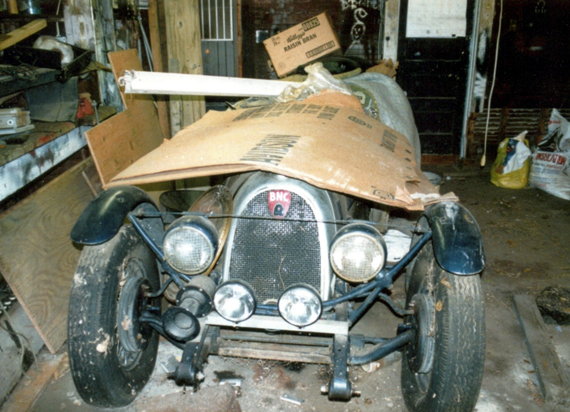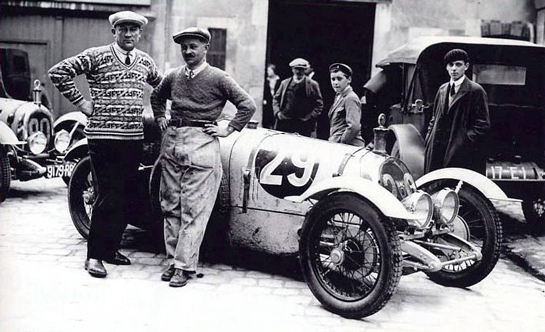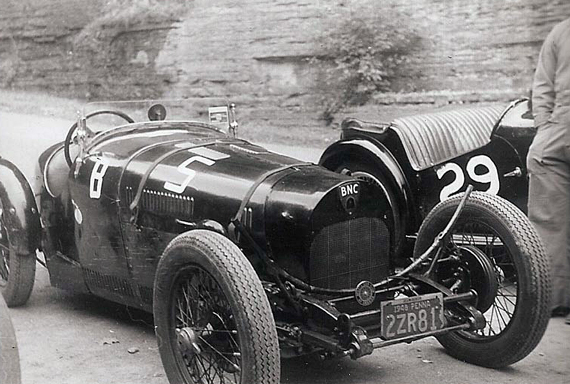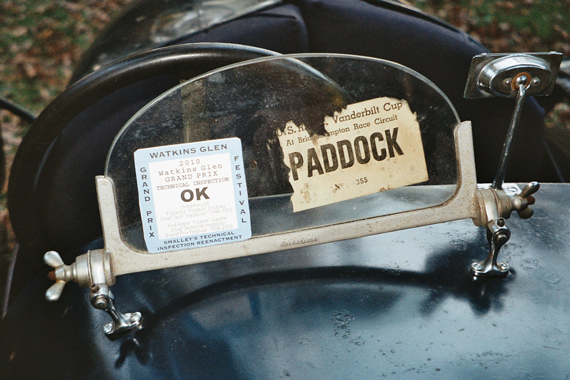Part 1 French Charm
By Eric Davison
In 2012 Eric Davison wrote a three part article about a BNC that had appeared at Watkins Glen in 1948. Below, we have combined all three parts into one for a unique, total account of this rare car. Sadly, the owner of the BNC at the time, George Lymber II. died on Oct 3 2013.
Getting involved in writing about old cars is something like a disease that is incurable. The symptoms keep on recurring. Case in point: Last year I was involved in helping my friend Phillipe Defechereux with the latest edition of his book about Watkins Glen in the period from 1948 to 1952. (Watkins Glen, The Street Years. 1948 – 1952. Dalton Watson)
The intention was to try to locate some of the cars that appeared at the Glen during those years and to tell where they are today. Unfortunately I had only a few months in which to work. To do a comprehensive job would take years and would make a pretty good book all by itself.
To our subscribers: Ignore the ‘comments are closed’ notice below as it is a software glitch; put your comments at the bottom of each article as before.
The famous cars were easy. Just about any car that Briggs Cunningham was involved with is in the Collier Museum in Florida. Talbot Lago Figoni coupes, while rare and wonderful, are easily traced. Poison Lil is a legend all by itself. Cars like 2.9 liter blown Alfas don’t disappear; they wind up in important collections. However it was the rare, unusual and not so famous cars that aroused my curiosity.
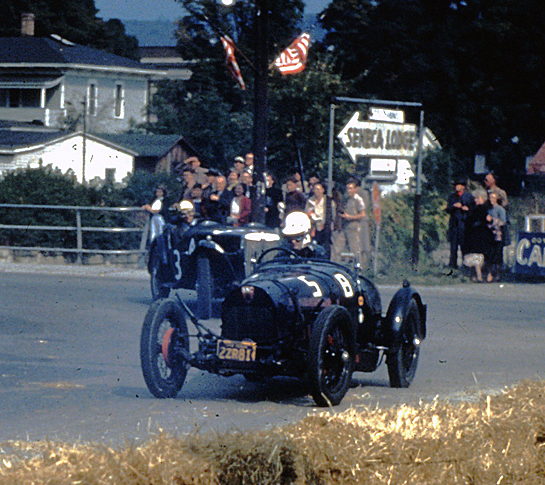
What's that car? Number 5 is George Caswell at Watkins Glen, 1948. The modified nose would make the car hard to identify. Behind him is the MG of Dean Bedford, Jr. Both cars would finish the Junior Grand Prix. Photo by Harold Lance.
In particular was the BNC. I had no idea what a BNC was; just that one had run at Watkins Glen in 1948 and had been driven by George Caswell. I could only speculate what had happened to the car. It was a spidery little two-seater that oozed personality and the only picture that I had of the car was as it was in the first corner of the Junior Prix.
When I thought I was done, I wasn’t even close.
A number of months later I wrote a series for VeloceToday.com (Watkins Glen: A Memoir) about my experiences as a teenager visiting Watkins Glen with my Dad during those early ‘street years.’
And what popped out of the woodwork? A gentleman named George Lymber wrote in to say that he was enjoying the series and that he was the current owner of that same BNC. I contacted George and here we are…the BNC. Lymber has owned the car since 2008 and has spent a lot of time tracking down its history. 1
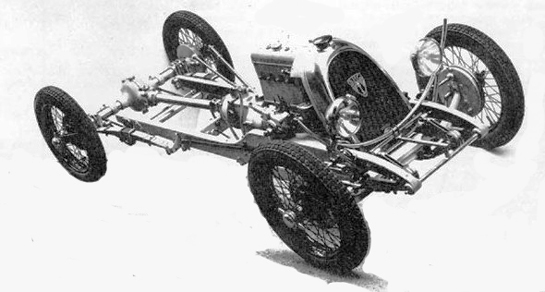
The first BNC models were still inspired by the JMK cyclecars but after 1924 until 1931, BNC developed a great number of the most attractive small sportscars in France. Some were even fitted with a supercharger. The first BNC were assembled in a small factory in Rueil-Malmaison, but the production soon moved to Levallois (a Paris suburb). These early BNC cars were equipped with Ruby 1095 cc and 1097 cc engines, made by the firm Godefroy et Levêque, who were practically neighbors Levallois. Courtesy Gijsbert-Paul Berk.
Serious students of vintage French automobiles will know that BNC stood for Bollack, Netter et Cie, a small manufacturer of sporty French cars. They began production in Paris on Avenue de Paris, 39 in the Levallois-Perret district. Levallois-Perret was an important location for the French auto industry. It was home to Delage, Citroen and the Chapron operation. Incidentally the Ile de la Grande Jatte is located on the Seine in Levallois-Perrett and is where Georges Seurat created his pointillist masterpiece “Ile de la Jatte.”
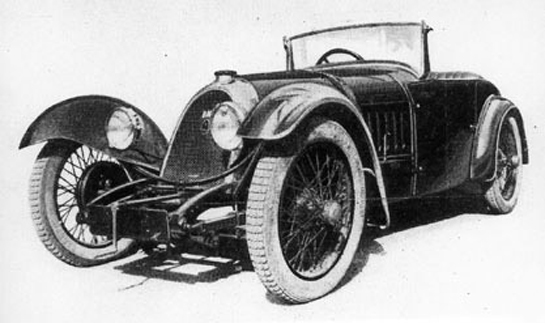
The BNC Type 527 at the peak of fame, 1929. Like the Amilcar and Salmson, they were considered 'poor man's Bugattis'. Photo courtesy Gijsbert-Paul Berk.
While the Brits were racing about their sceptered isle in MGs, Rileys and Austin 7s, the French were having a great time in their own countryside with a variety of delightful small sports cars. The best known of these was the Amilcar. A few examples still exist and show up at various vintage events. Another was Salmson. Like Amilcar, there were some very sophisticated versions. (Read about the Amilcar )
Until I started digging into this subject I never knew that the car driven into much hilarious mischief by Jacques Tati in Mr. Hulot’s Holiday was a Salmson. Later Salmsons were very sporty and fast. Also there was Mathis.
A very long time ago I saw a Mathis at an event in Michigan. That was probably 65 years ago and I haven’t seen one since. I did learn that Billy Durant was so taken with Mathis that he wanted to build a GM joint-venture Mathis alongside Oldsmobile at the Lansing, Michigan, Oldsmobile plant. 2
(Can you imagine the Rocket powered Mathis with HydraMatic and wrap around windshield?)
I don’t mention Bugatti as a small French sports car of the era. Bugattis, big and small, stand apart from every other vehicle of any era.
Footnote 1
October 5th, 2011, VeloceToday Comments section: “I enjoyed your article about the early Watkins Glen races. I presently own the #5 car entered in the 1948 race. It is a BNC-Ford special campaigned at the time by George Caswell. I would like to know if you have come across any photos of the car. Being a little obscure, both driver and car, I haven’t been able to find many photos of it. It only appeared in the 1948 race. Before and after, it ran quite a few Hill Climbs and then disappeared. I don’t have many records of this either, since sports car racing was still in its infancy, and not many records were kept. Thank you, I look forward to your next article”. George Lymber
Footnote 2
Durant not only wanted to build the Mathis, under the name of Matam–Mathis-Americana—(see “The Complete Encyclopedia of Motorcars, Georgano 1973 page 463) but was involved with doing the same for Amilcar, and bringing the tiny French car to Indy in 1928. ( See Amilcar )
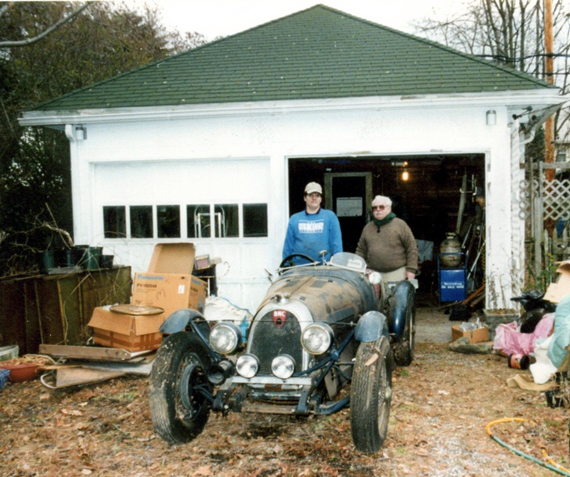
At left, Tony Lymber with John Gianella, who had so carefully and thankfully preserved the Caswell BNC. George Lymber photo.
Part 2 A Franco-American Hybrid
No one knows how George Lymber’s BNC reached America. We do know that a legendary figure of the early days of sports car racing, Otto Linton, (who was of great help in writing these articles) was a close friend and business associate of George Caswell, who purchased the car from motorcycle dealer George Taylor sometime in the early 1940s. Since both Taylor and George Caswell have both passed along to the great racetrack in the sky, there are no details to be had about the arrival of the BNC to these shores.
It is known that Caswell was a pretty serious motorcycle racer in the 30s, and that he and Linton became friends and associates because of a shared interest in fast bikes and fast cars.
BNC cars were just about like everything else at the time. They were pretty straightforward. Small displacement – BNC cars utilized mostly 1000cc Ruby engines – they had elliptical springs front and rear. There were four BNC body styles, all very sporty but the car in question appears to be the Torpedo Sport, Paris-Biarritz, the sportiest of the bunch and very Bugatti-like in appearance.
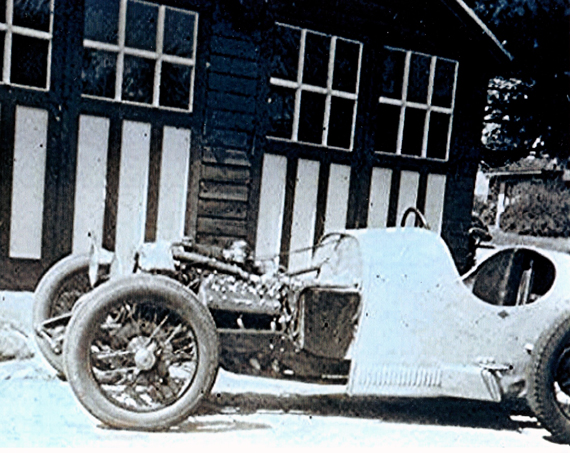
Otto Linton had this photo of the BNC taken in 1943 or 1944 as the Ford V8 60 was being installed. Nice fit but the original rear end was not up to it. Almost seventy years later, Sandy Leith recalled that the rear axle was supposed to have come out of a T30 Bugatti. Leith then had current owner Lymber verify the Bugatti S/N on the axle.
Caswell was interested in more performance than could be obtained by the little Ruby engine and he set about installing a Ford V8 60. Linton doesn’t remember ever seeing the little Ruby engine so it is possible that the car went to Caswell engineless. For those too young to know about the V8 60, it was Ford’s answer to the depressed economic times of the 1930s. The V8 60 was a cheaper alternative to the standard 85 hp V8 that powered most of Ford’s cars and trucks. 3
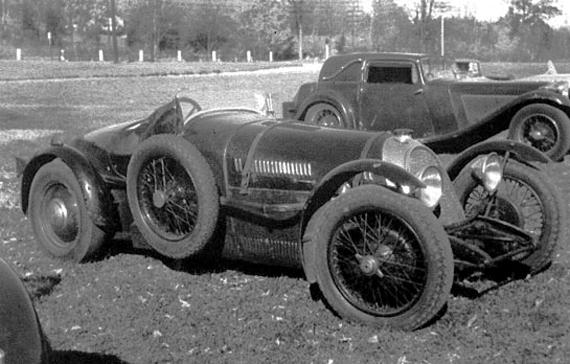
The BNC at an SCCA meet at Darien, Connecticut, probably in 1943. Now with the V8 engine, it appears roadworthy. Linton recalls that the cooling was marginal and it would overheat. This resulted in the change to the larger radiator and longer hood seen at the 1948 Watkins Glen Grand Prix. Otto Linton photo.
The V8 60 started life at 136 cubic inches and was produced in America through 1941. It was not a big success, most buyers preferring the bigger, faster standard 85 hp version. After the war the small V8 was replaced in the Ford line-up of engines by an in-line six. However, the tooling had been shipped to France where it powered a line of French Fords up to WW2 and after. Post war Ford Vedettes were V8 60-powered.
The V8 60 did find favor with a lot of performance seekers. V8 60s were a sweeping success on the midget racing circuits until the Offy made them and everything else obsolete. They were also stuffed under the hoods of a few sports cars. Phil Hill and Richie Ginther both drove a V8 60-powered MG TC, in California. John Fitch created the Fitch Type B, better known as the ‘Fitch Bitch’ by combining a V8 60 with a Fiat 1100 chassis and a highly modified Crosley Hotshot body. There were even a few small hydroplanes that utilized the V8 60.
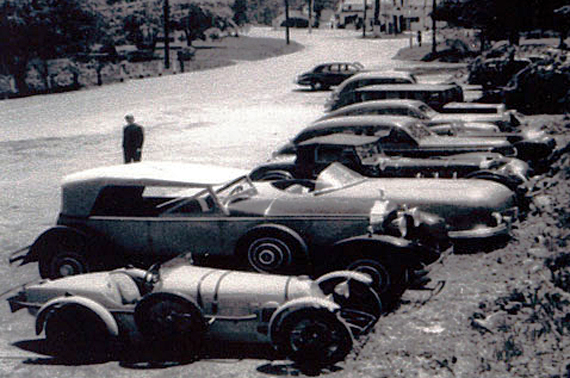
This is an evocative photo of an SCCA meet at Fairfield, Connecticut, probably in 1944. The BNC, now in primer, is seen with other SCCA cars of the era. The third car in line is the Russ Sceli Hudson 8 Complex, designed by Sceli with a Hudson 8 powerplant. Roger Barlow was the next owner and it disappeared in California. Photo courtesy Otto Linton.
Both Caswell and Linton wanted to join the SCCA and one of the requirements for full membership was ownership of a car identified by the SCCA as a true sports car. Otto Linton was in possession of a 1927 Duesenberg touring car. That was not a sports car. He located an Amilcar, acknowledged as a sports car, that was in need of an engine. 4
While Otto was not able to locate a suitable V8 60 for the Amilcar, Caswell did move ahead as fast as he could, finances permitting, to get his car up and running. He had a brief setback when the motorcycle dealer temporarily retook possession of the car until the payment schedule was met.
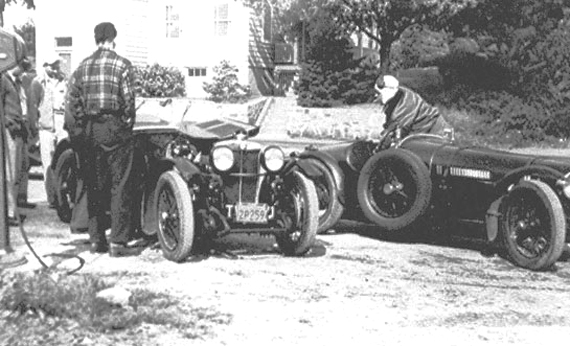
Otto Linton helped George Caswell with the BNC, but went on to buy an Amilcar and, sometime before 1948, a rare MG J4 which he raced at Watkins Glen that year. At left is Linton with the MG, standing behind the car. On the right, George Caswell in cloth helmet and the BNC.
Linton abandoned his Amilcar project and eventually purchased an MG J4, a nifty and rare supercharged model. In the picture of the start at Watkins Glen in 1948, Linton’s J4 is just behind Caswell’s BNC. 5
Caswell used the BNC in hillclimbs and other events along the east coast. He found that the standard radiator would not properly cool the newly modified car so a larger radiator was installed. Also, the light weight BNC rear axle was determined not to be up to the task and what George Lymber discovered to be a Bugatti rear axle was fitted. For a time the rear wheels and tires appeared to be of Ford origin with big hub caps and short, fat, spoked wheels. It is possible that the Ford axle setup was tried and proved to be either wrong in ratios or too heavy. Photos show that the possible Ford rear end might have been an intermediate or temporary step.
Caswell and Linton did find some competition events. Linton drove the car at Thompson Speedway in 1947 while Caswell participated in a hill climb in Fairfield, Connecticut in 1947, Langhorne Speedway in 1951 and the Giant’s Despair Hillclimb in 1951.
When the BNC appeared at Watkins Glen in 1948, the rear wheels appeared to be the originals but it is pretty certain that the Bugatti rear axle was in place. While the car appeared with a modified radiator, it seems that Caswell was later able to re-install the original and beautiful Bugatti-like radiator and shell.
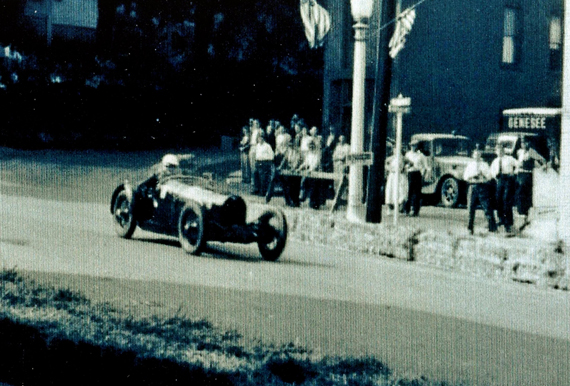
The Franco-American BNC's finest hour: Caswell at Milliken's Corner, Watkins Glen, 1948. Caswell would finish 8th overall. Evelyn Caswell photo.
The 1948 event was the first and last appearance at Watkins Glen for the BNC and for Caswell. Not so for Otto Linton, who later went on to race a couple of the most beautiful cars ever to appear there; a delightful Crosley powered Siata and later a two-liter Siata V-8 coupe.
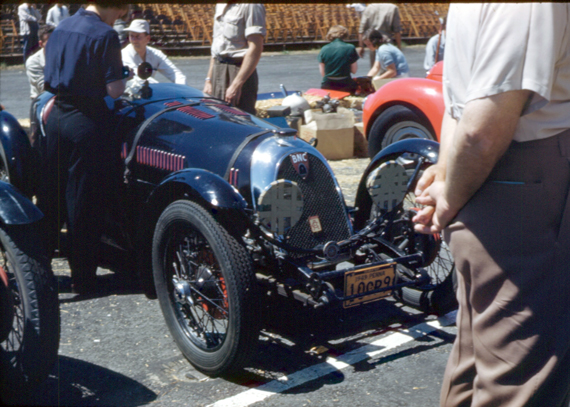
Bill Giltzow's father captured the Caswell BNC at Linden, N.J. in 1949. The original radiator was put back in place and overall, the car appears to be in excellent form. Bill also found the program to the 1949 Linden event, where Caswell had entered the BNC. Photo copyright Bill Giltzow.
Footnote 3
In a letter to George Lymber dated June 2009, Linton provides a detailed history of the BNC in the postwar period when in the hands of Caswell.
Footnote 4
“My 1927 Duesenberg touring did not qualify.” Letter from Linton to Vack dated 1-21-11. Caswell owned the BNC and Linton had to wait to find the Amilcar, which also needed an engine. However, that led to another find, the MGJ4 which he then used in SCCA events. By 1951, Linton was heavily involved in Italian cars such as the new Siatas.
Footnote 5
In a letter to Tony Carroll dated October 2010, Linton describes The Amilcar as a very special racing C6, (six cylinder DOHC) which after a long period of time was then sold to Chris Leydon at Leydon Restorations. It was, recalls Linton, really his third Amilcar.

The Caswell BNC Ford as it appears today, cleaned up but unrestored 'as last raced,' to quote Fred Simeone. Photo courtesy George Lymber.
Part 3 Preserving History
It is hard to determine the ownership succession of a car like the BNC. We do know that Caswell bought it as a used car, after which he modified it and competed with it before it changed hands. To whom it went next is a mystery.
It was reportedly in the hands of Eric “Sonny” Grainger for a time. Grainger was the track announcer at the Islip, Long Island race track for a period and in 1955 was one of the founders of the Bridgehampton circuit.
The next known owner was Chuck Molin, who purchased the car for himself after he graduated from high school. His affair with the BNC was short-lived and when he left home to seek his fortune the car was abandoned in the family garage. That was most likely around 1959.
John Gianella was a neighbor and while he didn’t know exactly what the car was, he knew it was a delightful little sports car that was stashed away. An inquiry to Molin’s mother revealed that yes, there was a car in the garage and “I think it might be a Bugatti!” While it surely wasn’t a Bugatti. it was most definitely a BNC with V8 60 power. In 1960 Gianella made a deal and became the next owner. Gianella kept the car for the next 48 years. He used it regularly and with enthusiasm for the first 10 of those years. 6
There is still a sticker on the windshield that shows a Bridgehampton 1960 competitor’s credential. John Gianella was a regular participant at many events on the Eastern Seaboard. The BNC was back to being a sports car. Somewhere along the line, the spindly BNC wheels were replaced by what appears to be those from a Jaguar of the XK series. Someone, presumably Caswell, had replaced the cable-operated brakes with more substantial and effective hydraulics.
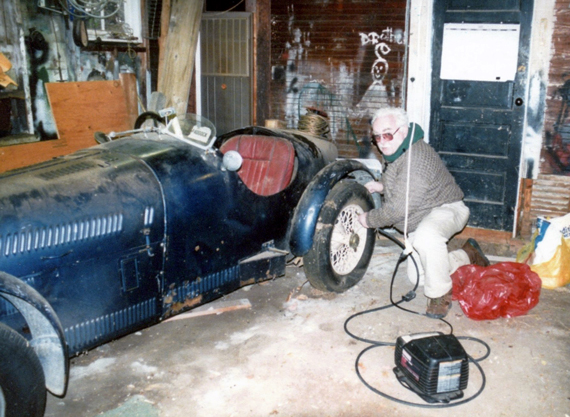
John Gianella checking tire pressure while getting the car ready to be passed on to its new caretaker. Photo by George Lymber.
In the early 70s Gianella’s interests took him in other directions and the little BNC occupied a space in his garage and like many old interests, it became an object of clutter. By 1990 the car was pretty well buried under boxes and other ‘stuff.’
George Lymber and John Gianella were friends, but George had no idea that John even owned the car or that there was a car buried in his garage until Gianella decided to relocate and George Lymber volunteered his help in the move to another home nearby on Long Island. Lymber, a VSCCA member, was thrilled with the find.

BNC instrument panel is full of later-era gauges. Note steering wheel mount. Photo by George Lymber.
Being a patient man, George never pressed his friend to sell the car but after seven or eight years in which the car continued to sit in its new location, it became apparent to Gianella that it was time to let it go.
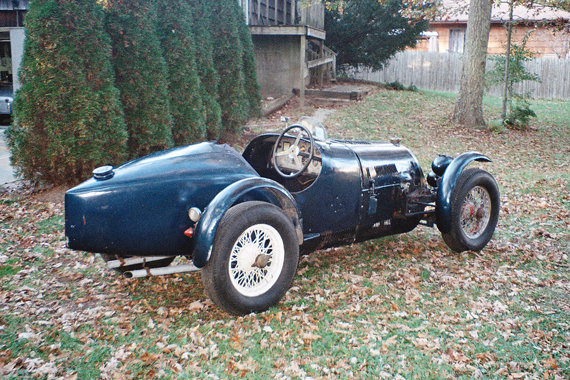
Somewhere along the way the V8 received twin pipes, a very popular modification for V8s in the 1950. Photo by Goerge Lymber.
It was then, in 2008 that George Lymber became the latest owner of the BNC V8 60. In the time that Lymber his owned the car, he has not tried to restore it. It had been painted, the original radiator shell had been remounted and newer wire wheels had been mounted. There was not much else to do other than clean it up. While it does not yet run, it will soon.
It is his intention to bring it back to life as a “survivor,” a car to be savored for its patina and its unusual history. It is like a lady with a past, far more intriguing and interesting than the girls your mother would have preferred for you.

George Lymber stands next to the BNC before taking it home. Thankfully, Lymber will preserve rather than restore. Photo courtesy George Lymber.
It is also interesting that the little BNC never strayed far from home. It was in Philadelphia that Caswell and Linton started it on its way and since then it has never lived anywhere other than Long Island.
Lymber took the BNC to Watkins Glen in 2010 for a static appearance and enthusiasts did not have to be familiar with the car or its history to be charmed.
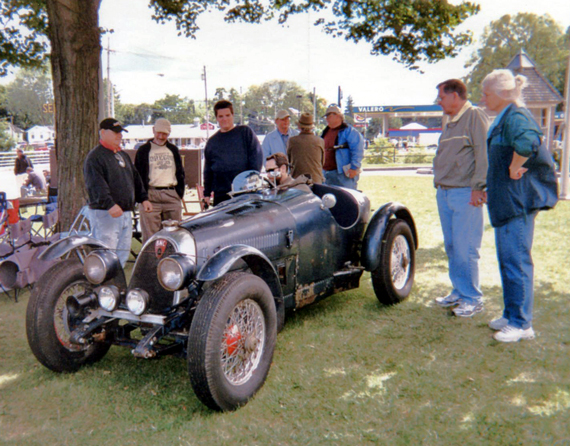
The Caswell BNC, still looking good 64 years after its 8th place finish at Watkins Glen, seen here at a car event on Long Island. Photo by George Lymber.
George Lymber is now the curator of a delightful part of automotive history and I hope that the car makes numerous appearances at suitable vintage events. It needs to be seen and George intends to keep it alive and to let enthusiasts savor its French savoir faire.
I have been told that there is another BNC residing somewhere in the US. For sure there is no BNC owner’s club. Perhaps somewhere among the readers of VeloceToday, there are other BNC owners or those with either photographs or remembrances of George Lymber’s car. If so, he would like to hear from them.
Footnote 6
Phone conversation with John Gianella, December 2011.
Our thanks to Eric Davison, Gijsbert-Paul Berk, Sandy Leith, Tony Carroll and of course George Lymber.
You can find more information on the website of the very active club,Amicale BNC.
Other useful websites:
http://www.laberezina.com/anciennes_voitures/A-L/bnc.htm
And
http://gtfrance.free.fr/bnc.html
Here is a paragraph about George Lymber II from his online obituary:
George Lymber II graduated from Bay Shore High School in 1966, and received his B. A. from Adelphi College, Suffolk branch in 1970. He graduated from the Datsun Motor Co. Engine Rebuilding School in 1972, and SUNY in 1974 completing courses in Diesel Engines. George was an outside contractor maintaining the Bell Atlantic Fleet, Mechanic, and Field Mechanic for various garages on Long Island. He had his N.Y.S. CDL Class A License and was qualified to repair these trucks. He loved foreign cars, owned a white 1969 Jaguar XK-E, that won an award for being the most beautiful car in show from the V.S.C.C.A., and owned many Alfa Romeo’s, M G’s, and Allards. He became the 5th owner of a 1929 B.N.C. (Bolleck Netter Co.) race car that was made in Paris, France and it ran in the first Watkins Glen Grand Prix in 1948, owned and driven by race car driver George Caswell. Any car guy would have loved George’s house. He had a Alfa engine hanging on a engine stand in his kitchen, and a industrial size bottle of hand cleaner screwed to the kitchen wall. He had 20 motorcycles in his house, and 40 more in outside tents. George was loved and will be remembered by all of his friends.
